Fall 2007 Arch. 451: Architecture Design V (UG) Carbon Neutral Studio
Pedagogy Overview, Philosophy and Strategies
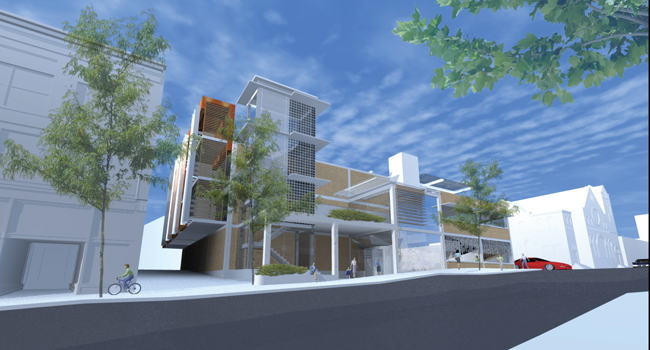
Design Performance Objective |
Adaptive Reuse
Adaptive Re-use of existing YWCA facility in Elgin, IL included user group inputs through student interviews. Student team constructed an outline of sustainable features, integrating systems to reduce energy use, maximize solar harvesting, improve daylighting and vegetation, and manage rainwater on-site.
|
Students: Heidi Hurst, Ben King |
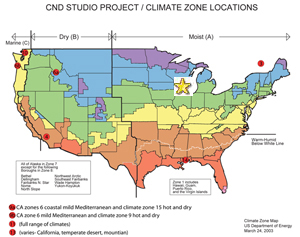
This particular studio project was located in the host institution's own climate zone, COLD. The principles of the studio could be applied to any climate zone. |
| |
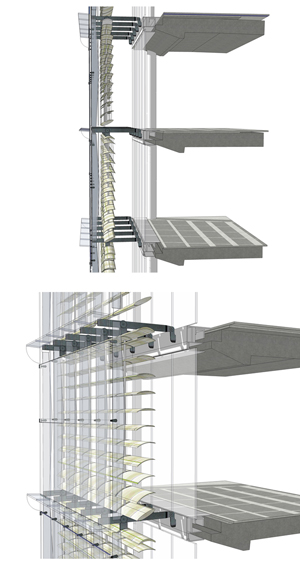 Case Study of Bayer by MurphyJahn
Stewart
Case Study of Bayer by MurphyJahn
Stewart |
| |
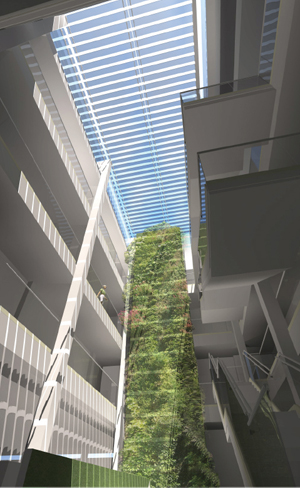 Adaptive Re-use
Matt Kidd, Heidi Hurst, Ben King
Adaptive Re-use
Matt Kidd, Heidi Hurst, Ben King
The deep plan configuration of the existing building was surgically opened up and adapted for daylight, vegetation and fresh air |
|
Fall 2007 Arch. 451: Architecture Design V (UG) Carbon Neutral Studio
Keelan Kaiser, AIA
Professor of Architecture
Interim Chair, Division of Art, Design and Architecture
Judson College
kkaise@artic.edu
This course is located at the fourth year in a six-year degree program. The course is typically structured as a five-week sustainable neighborhood design problem followed by a ten-week building design problem.
I take a rules of thumb approach to “teaching” CND principles in the studio. We need as much land as the footprint of the building for on-site water management, we need to provide roughly the same square feet of PV as gross square feet of facility (in Chicago, IL) in order to approach zero net energy, and so on. Studio pedagogy is as diverse a subject as one could imagine in academia, so my interest is not so much synthesizing a universal approach to CND as it is to hone in on the handful of “first principles” and ensure that students have grasped their importance before beginning future studios...
Program Statement
A 30,000 g.s.f. Magnet High School with an emphasis in Ecology, this program follows an earlier city plan to locate a new school in this area. The neighborhood site is within city and infrastructure, but vacant. The sites sit along the Fox River and include riparian connections.
The neighborhood and building were chosen because of the perceived need to have the students think beyond the perimeter of the building shell when considering the macro scale issues with CND. Since the building would need to be 2-3 stories, PV would not solve the energy needs entirely.
We also looked at health and welfare issues in conjunction with energy issues (e.g. natural ventilation for improved IAQ, passive solar and daylighting, on-site food production, integrated vegetation, etc. (i.e. Kellert: Building for Life).
An ulterior motive was to use the products of the class to educate the local community in sustainable architecture, envisioning this neighborhood being a low-impact alternative to suburban Greenfield development.
The hope was that this would stimulate discussion among the city council and development community to consider the opportunities to develop mixed-use density within the existing city core. Some progress resulted, and the city has a Sustainable City Masterplan RFP out. I would like to think that some of this work has played a small role in encouraging this thinking in city leadership.
CLIMATE TYPE PROFILE
X-Large – residential and mixed use neighborhood land planning/urban design
Large – School building type - Elgin, Illinois
The project will respond to NAAB (CACB) Student Performance Criteria
#15. Sustainable Design
Understanding of the principles of sustainability in making architecture and urban design decisions that conserve natural and built resources, including culturally important buildings and sites, and in the creation of healthful buildings and communities
#17: Site Conditions
Ability to respond to natural and built site characteristics in the development of a program and the design of a project
#19: Environmental Systems
Understanding of the basic principles and appropriate application and performance of environmental systems, including acoustical, lighting, and climate modification systems, and energy use, integrated with the building envelope
#21: Building Envelope Systems
Understanding of the basic principles and appropriate application and performance of building envelope materials and assemblies
#28: Comprehensive Design
Ability to produce a comprehensive architectural project based on a building program and site that includes development of programmed spaces demonstrating an understanding of structural and environmental systems, building envelope systems, life-safety provisions, wall sections and building assemblies and the principles of sustainability (to a more limited degree given the beginning design nature of the course projects) |
Investigative Strategy |
TEACHING TOPICS PROFILED
1. Building Massing/Site Design
This topic is a critical first step. The building massing must address passive solar as a foundational site opportunity.
2. Indoor Air Quality
The objective then, for the design studio, is for the students to demonstrate that 1) air can move through the environments they have created without relying on fans, and 2) they understand some of the barriers to designing for fresh air.
3. Daylighting, Passive Solar and Solar Control
This topic combines two primary exercises. The first objective is to provide for passive solar gain in during a 5-6 month period of the year to lessen heating demand. The second objective is to integrate effective daylighting in conjunction with the passive solar strategy.
4. Building Integrated Photovoltaics
Combine photovoltaics as an on-site renewable energy strategy with the built form of the studio project.
5. Adaptive Reuse (Alternative Approach 1)
Using existing building stock, transform a building from its original use to a new use as a means of limiting new construction to demolition redesign of existing infrastructure and finishes as needed.
6. Neighborhood Design (Alternative Approach 2)
Design a green community development plan on an existing municipal site.
THE TEACHING TOPICS IN THE CONTEXT OF THE COURSE
Since it is a studio it is hard to partition the decision making flow from one topic to another. They are all introduced and investigated simultaneously. Granted this is senior level and graduate work, so the mature student is able to manage these issues simultaneously better than a beginning or intermediate level student. The neighborhood design actually comes first in the sequence to set the stage for a larger view of sustainable design, then the building project follows with the four topics covered here.
|
Information about the Project and Studio |
This course is located at the fourth year in a six-year degree program. The course is typically structured as a five-week sustainable neighborhood design problem followed by a ten-week building design problem.
• compilation PDF
• course outline |
Philosophy of the Studio Instruction |
Carbon Neutrality in the built environment includes two main considerations: now-conventional views of low energy and high performance buildings and site/building oriented regeneration strategies. The former has gained traction in both academia and practice, while the latter continues to be a vision of only a few, since addressed formally by Lyle in the 70’s, revisited by Orr in the 90’s.
One means by which I am communicating with my students is by addressing health and welfare issues inherent in the building enterprise. This touches on values, as I have observed them, held by the majority students. I have found Building for Life and Biophilic Design, both authored by Steven Kellert, to be particularly useful in communicating the value of healthy buildings and our interrelation to nature and natural systems. I also like these titles because they fit nicely with my own value of life and position architecture and the built environment to affect positively human experience and quality of life. The works are not limited to science but introduce a faith and spiritual perspective that I find refreshingly human and beyond the mechanical.
I take a rules of thumb approach to “teaching” CND principles in the studio. We need as much land as the footprint of the building for on-site water management, we need to provide roughly the same square feet of PV as gross square feet of facility (in my location) in order to approach zero net energy, and so on.
Studio pedagogy is as diverse a subject as one could imagine in academia, so my interest is not so much synthesizing a universal approach to CND as it is to hone in on the handful of “first principles” and ensure that students have grasped their importance before beginning future studios. Like principles of building safety, accessibility, and energy, CND can parallel these first principle values. Of course, the key is to communicate value to the student, or in practice to the client.
I have used a two-part exercise in teaching low energy and high performance building concepts in studio. On the one hand, I have my students research a particular building and conduct a case study of that work, focusing on a building envelope strategy. This usually takes an architectural expression direction. But there is value in this, because it stimulates curiosity in the relationship between built form and building performance.
On the other hand, the students build a digital section model of a key zone of the building they have studied. I find this to be superior to a section drawing, since the student builds all of the components present in a section drawing and elevation. The model is usually extruded approximately 12’-20’ to accommodate elevation considerations as well. The student can then visualize the principle (section diagram perhaps) as well as the execution (the built assembly) of the assembly system at work. Of course, this can be visualized from multiple views; solar geometry and daylighting can be assessed against the model, etc.
An important part of the CND equation for my teaching is the inclusion of regeneration concepts. Regeneration involves generating, in addition to necessarily depleting, renewable energy and resource production on-site. On-site water and waste treatment and management, power generation, food production, habitat and biodiversity, are but a few items that I discuss and value during studio.
It is not without difficulty. It is entirely another scale of commitment to design for regeneration; and it tends to be land intensive, natural resource intensive, solar access intensive, to name a few of the critical site needs. It is also clear that there are limits to regenerative design, and it might be that regeneration can only truly happen at a larger scale, say that of a neighborhood or larger. But the future of the built environment must include regeneration to reach a truly sustainable world with self-supporting built environments.
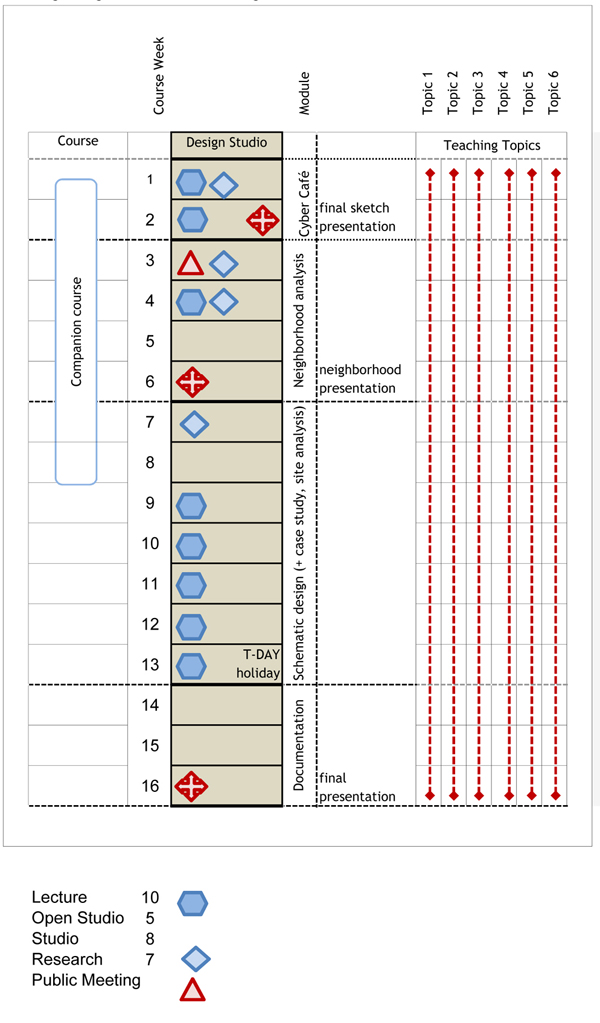
Studio Topics Key
|
List of 10 critical issues in my teaching of Carbon Neutral Design |
1. Thick, but not fat, east-west orientation, , with parallel considerations of daylighting, natural ventilation, construction efficiency, and access to natural environments.
2. PV, Green roof/wall, Rainscreen: all Integrated, not applied
3. Thermal mass exposed to interior to lower indoor temperature swings during natural ventilation modes
4. Integration of passive solar as a given requirement for any CND project to harness solar radiation energy
5. Appropriate solar shading on E, S, W, each one customized to orientation, to minimize cooling load
6. Cross ventilation: mitigate cooling, IAQ, increase user control
7. Stack ventilation: mitigate cooling, IAQ, night flushing
8. Include users/civic leaders in programming, process, and review
9. Include all considerations for how the building and site can harness and harvest natural and renewable resources
10. Privileged building performances issues as a parallel consideration to all other design priorities including client needs, aesthetic approach, and cost evaluation; i.e. parallel considerations, not in series.
|
10 student design mistakes that undermine the goal of Carbon Neutral Design |
1. Inadequate response to solar geometry
2. Building performance considerations after preliminary design
3. Tack-on applications rather than integrative thinking
4. Building massing/decisions related to harnessing and harvesting
5. “The mechanical engineer can make my design work”
6. A priori building performance thinking will constrain innovation
7. Solar shading can be treated the same on all elevations
8. Conventional thinking about MEP
9. Thinking CND is about calculations/proofs alone
10. Thinking CND can be achieved without calculations/proofs |
|
Range of Applicability in terms of CLIMATE |
ALL |
Range of Applicability in terms of TYPE |
All |
Reference Material |
PAPERS
Kaiser, K. A green studio pedagogy: using scale changes to influence architectural design for sustainability. 2007 Architectural Research Centers Consortium (ARCC) conference.
BIBLIOGRAPHY:
Building for Life, Stephen Kellert, Island Press, 2005, ISBN 1-55963-721-8
Sustainable Architecture and Urbanism, GauzinMuller, Birkhauser, 2002, ISBN 3-7643-6659-1
Green Studio Handbook, Alison Kwok and Walter Grondzik, Elsevier, 2007, ISBN 0-7506-8022-9
Community by Design, Hall and Porterfield, McGraw Hill Publishing, ISBN 0-07-134523-X
Design Thinking, Peter Rowe, MIT Press, ISBN 0-262-68067-0
Site Planning, Kevin Lynch and Gary Hack, MIT Press, ISBN 0-262-12106-9
The Nature of Design: Ecology, Culture, and Human Intention, David Orr, Oxford University Press, 2002, ISBN 0-19-514855-X
ON THE WEB:
Green Globes: www.greenglobes.com
Ecocalculator: www.athenasmi.ca/tools/ecoCalculator/downloadEcoCalculator.html
US Green Building Council: www.usgbc.org
LEED® for Neighborhood Dev.: http://www.usgbc.org/DisplayPage.aspx?CMSPageID=148
LEED® for New Construction: http://www.usgbc.org/DisplayPage.aspx?CMSPageID=220
|
Degree of Difficulty / Previous Knowledge Required |
This is an intermediate to senior level studio. |
x |
|
|
|
|

